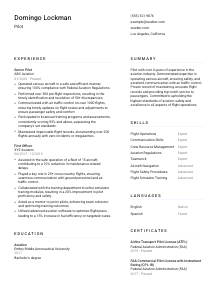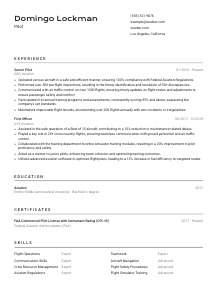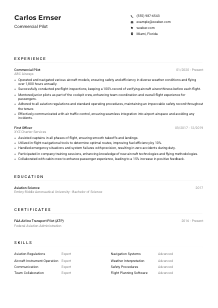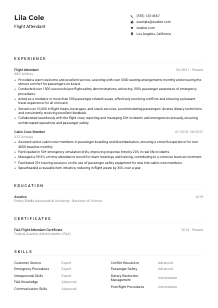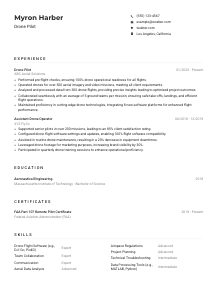Pilot Resume Example
Taking flight, but your resume feels grounded? Soar high with this Pilot resume example, prepared using Wozber free resume builder. Discover how you can navigate your aviation expertise to align smoothly with job checkpoints, propelling your career to new horizons!
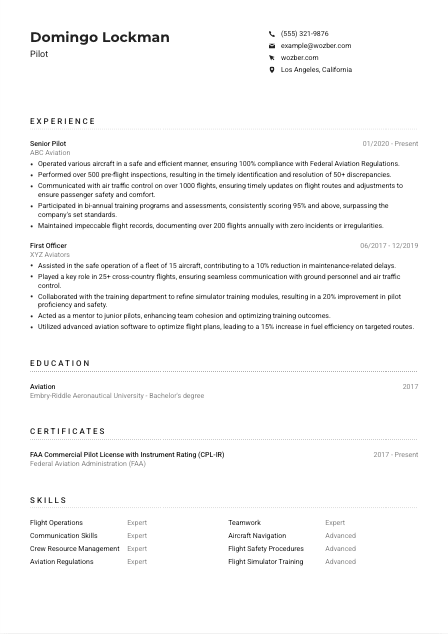
How to write a Pilot Resume?
Hello, aspiring Pilot! The journey to your dream cockpit starts with a single step - crafting a resume that flies straight into the heart of hiring managers. But this isn't any ordinary resume; it's a meticulously designed, ATS-compliant masterpiece that showcases your high-flying skills and experiences. With the right altitude and attitude, guided by Wozber's free resume builder, you're about to learn how to create a resume that not only meets but exceeds job descriptions.
Ready for takeoff? Strap in, and let's navigate the skyscape of your professional journey together!
Personal Details
First impressions count, and in the aviation world, they're your passport to success. Let's make your personal details section as polished as the exterior of a Boeing 747, ensuring it aligns perfectly with your Pilot position aspirations.
1. Your Name as Your Call Sign
Your name is your call sign, the first thing the tower -- or in this case, the hiring manager -- hears. Make it prominent, clear, and unmistakable. Think of it in terms of cockpit visibility: can it be seen and recognized at a glance?
2. Matching the Job Title to Your License
Below your name, your title isn't just 'Pilot' - it's a badge you've earned. Whether you're a 'Commercial Pilot' or an 'Airline Transport Pilot,' align it with the job description. It shows you're not just in the right airspace, but you're cleared for this specific runway.
3. Contact Coordinates
Your phone and email are your radio frequencies. They must be clear, operational, and professional. Double-check them as you would your pre-flight checklist. A missed call or an unread email could mean missed opportunities.
4. Base Location
"Must be located in or willing to relocate to Los Angeles, California." If you're already based in L.A. or planning to relocate, highlight this in your resume. It's like having the right home base for immediate deployment.
5. A Professional Profile or Website
Consider adding a LinkedIn profile or a personal website if it showcases your professional achievements, certifications, or any aviation-related content. It's like leaving breadcrumbs for recruiters to discover more about your flight path.
Takeaway
Craft your Personal Details section with the precision of filing a flight plan. It sets the course for the journey ahead, ensuring you're portraying a professional image ready for takeoff. Remember, making a great first impression is like clearing the runway - it makes for a smoother ascent in your career journey.





Experience
The Experience section of your resume is like your flight log. It's a record of all the places you've been professionally, the skills you've mastered, and the challenges you've overcome. Here's how you tailor it to soar above the rest, crucial for navigating the ATS airspace.
- Operated various aircraft in a safe and efficient manner, ensuring 100% compliance with Federal Aviation Regulations.
- Performed over 500 pre‑flight inspections, resulting in the timely identification and resolution of 50+ discrepancies.
- Communicated with air traffic control on over 1000 flights, ensuring timely updates on flight routes and adjustments to ensure passenger safety and comfort.
- Participated in bi‑annual training programs and assessments, consistently scoring 95% and above, surpassing the company's set standards.
- Maintained impeccable flight records, documenting over 200 flights annually with zero incidents or irregularities.
- Assisted in the safe operation of a fleet of 15 aircraft, contributing to a 10% reduction in maintenance‑related delays.
- Played a key role in 25+ cross‑country flights, ensuring seamless communication with ground personnel and air traffic control.
- Collaborated with the training department to refine simulator training modules, resulting in a 20% improvement in pilot proficiency and safety.
- Acted as a mentor to junior pilots, enhancing team cohesion and optimizing training outcomes.
- Utilized advanced aviation software to optimize flight plans, leading to a 15% increase in fuel efficiency on targeted routes.
1. Break Down the Job Requirements
Identify the essentials. For a Pilot, the job description mentions, "Operate aircraft in a safe and efficient manner, ensuring compliance with all Federal Aviation Regulations (FARs)." Reflect on your career: when have you demonstrated this?
2. Structure with Roles and Companies
Your flight history should have a clear timeline, like a flight itinerary. Begin with your most recent role as 'Senior Pilot' and work backward. This chronology helps recruiters understand your flight path and how you've ascended in your career.
3. Craft Targeted Accomplishment Statements
Each bullet is a highlight reel of your career. Did you conduct "over 500 pre-flight inspections"? It's not just about the inspections; it's about ensuring passenger safety and compliance with aviation standards. Tailor each point to reflect your achievements in relation to the job description.
4. Quantify Achievements When Possible
Numbers add credibility. When you mention "Communicated with air traffic control on over 1000 flights," it gives a scale to your experience. It's like confirming your hours logged in the cockpit, a crucial metric for any aviator.
5. Keep It Relevant
Trim the fat from your resume like you would before a long-haul flight to ensure efficiency. Highlight experiences that are directly relevant to the role of a Pilot. While your summer as a lifeguard might have honed your stress management, focus on what pertains to aviation.
Takeaway
Your Experience section should reflect a career trajectory that's always been headed towards the pilot's seat, with each role serving as a crucial waypoint. Through careful tailoring and ATS optimization, make it evident that you're the candidate they want in their cockpit. Your carefully recorded log shines a spotlight on your qualifications and readiness to fly high in this role.
Education
In the world of aviation, your education is not just about knowledge but the foundation of your flight capability. Here's how to frame your academic accomplishments to land in the 'qualifications met' zone of the ATS while directly addressing the co-pilot's seat of this job.
1. Identify Key Educational Requirements
The job description requests a "Bachelor's degree in Aviation, Aeronautical engineering, or a related field." If your degree takes off from here, you're already on the right runway. Make sure this is clearly highlighted.
2. Structure with Simplicity
Your education section should read like an easy cockpit checklist - clear, direct, and in compliance. List your degree, the institution, and the graduation date in an easy-to-scan format.
3. Tailor Your Degree Details
If you have a degree in Aviation or a related field, state it explicitly as such. Matching the exact words from the job description can help your resume's visibility in the ATS. It's like speaking the same language as air traffic control - it eliminates misunderstandings.
4. Highlight Relevant Courses
For a pilot, specific coursework can set you apart. While the broad degree covers most bases, mentioning specialized courses like "Advanced Instrumentation" or "Air Traffic Control Communication" could elevate your resume to first class.
5. Other Educational Achievements
Were you a part of an aerospace club or did you lead a project on flight safety? Such achievements add lift to your resume, showing a commitment to your field beyond just coursework. However, keep altitude awareness - relevance is key.
Takeaway
Like mastering aircraft systems, understanding how to effectively present your educational background is pivotal. Ensure it's aligned with the job's altitude and attitude requirements, showing you have not only the theoretical foundation but also the dedication to aviation excellence necessary for this role.
Certificates
Certificates in the aviation world are more than just accolades; they are your license to fly. Showcasing the right certifications can be the wind beneath your wings, proving your expertise and ongoing commitment to aviation safety and excellence.
1. Relevant Certificates
"FAA Commercial Pilot License with Instrument Rating" is not just a requirement; it's a testament to your qualifications. Highlight your certification prominently, ensuring it's easily spotted by the ATS - think of it as your transponder code, making you visible to air traffic control.
2. Prioritize and Prune
Keep your certificates section aerodynamic by listing only those most relevant to the position. Focus on quality, not quantity. Each certificate listed should serve as evidence of your suitability for the Pilot role.
3. Dates Matter
Just as flight plans are time-bound, the dates of your certifications matter. Specify when you earned them, especially if they're recent. It shows you're up-to-date with current aviation standards and practices.
4. Stay Current
The aviation field evolves, and so should you. Continuously updating your certifications and seeking out new qualifications shows a commitment to your profession. It's like keeping your craft airworthy, ensuring it meets all current safety and operational standards.
Takeaway
Think of your certifications as your plane's registration and airworthiness certificates - without them, you're not going anywhere. By carefully selecting and presenting your certifications, you demonstrate your dedication to maintaining high standards in your profession. They're your clearance for takeoff in the application process.
Skills
In the cockpit and on your resume, skills make all the difference. They're the instruments that help you navigate complex situations and demonstrate your readiness for the Pilot role. Let's calibrate your skills section for optimal performance in the ATS airspace.
1. Extract Key Skills from the Job Description
Start by charting your course: Which skills are highlighted in the job ad? "Strong interpersonal and communication skills" and "Ability to work in a team-oriented environment" are just the tip of the iceberg.
2. Align Your Skills
Match your skills with the job's requirements. If the description emphasizes "Flight Safety Procedures," and you're proficient in them, make it visible. This is like aligning your flight path with air traffic control's directives - it ensures you're on the right course.
3. Organize and Prioritize
Keep your skills section streamlined. Focus on the skills that will have the most impact, ensuring they're both ATS-friendly and aligned with the job description. Consider this organization like a pre-flight checklist, ensuring everything is in order before takeoff.
Takeaway
Think of your skills section as your flight plan. It needs to be clear, concise, and directed towards your destination: the job at hand. By carefully curating this section, you signal to hiring managers and ATS systems alike that you have the exact skill set they're seeking - your professional instruments are perfectly calibrated for the role.
Languages
In the diverse airspace of our global society, the ability to communicate in multiple languages can set you apart as a Pilot. It's like having access to direct routes in controlled airspace - it can make your journey smoother and expand your horizons.
1. Essential for the Role
When English is specified as a requirement, as it is with "Ability to communicate professionally in English is required," it's a no-brainer. Highlight your proficiency level to show you're ready to communicate effectively in the aviation world's lingua franca.
2. Add More Languages
Listing additional languages can demonstrate your capability to interact with a diverse crew and passengers. It's like showing that you can navigate through different airspaces without any communication barriers.
3. Clearly State Your Proficiency
Be honest and clear about your language levels. Whether you're a native speaker or fluent, properly indicating your proficiency ensures expectations are set correctly from the start, much like communicating your fuel levels during a flight plan.
4. Know the Scope
Understanding the role's requirements and expectations will guide you on which languages to include. If international flights are a part of the job, showcasing multiple languages could be a significant advantage, much like having the right navigation charts for international waters.
5. Value of Being Multilingual
Even if not explicitly required, bilingual or multilingual abilities are always a plus. They show your adaptability and willingness to engage in global conversations, an essential skill in the ever-expanding aviation industry.
Takeaway
Your linguistic skills are like your passport - the more languages you speak, the more destinations you can explore. Highlighting language proficiency on your resume opens new runways for your career, enabling smoother communications and broader horizons in the diverse world of aviation. Be proud of your linguistic skills; they can make your resume flight plan even more compelling.
Summary
Your resume summary is your initial ascent, giving the hiring manager a bird's-eye view of your qualifications. A well-crafted summary ensures you rise above the clouds, displaying your unique combination of skills and experiences tailored to the Pilot role.
1. Grasp the Job's Core
Before drafting your summary, fully understand what the job entails. For a pilot, safety, communication, and proficiency in aviation regulations are key. Showcase your expertise in these areas right off the runway.
2. Lead with Experience
Start with a strong statement about your professional background: "Pilot with over 4 years of experience in the aviation industry." This sets the stage, immediately confirming your qualifications for the role.
3. Highlight Your Skills
Mention your standout skills and accomplishments: ensuring safety, excellent communication with air traffic control, and a proven record of maintaining accurate flight records. This tells the hiring manager you're not just qualified; you're exceptional.
4. Precision and Brevity
Keep your summary concise, like a clear air traffic control communication. Aim for 3-5 lines that encapsulate your experience, skills, and what makes you the ideal candidate for the Pilot position.
Takeaway
A strong, tailored summary gives your resume lift, positioning you for a smooth landing into the interview round. It's your chance to convey confidence, capability, and fit for the job in a snapshot. Use it wisely to capture the essence of your professional journey and aspirations, setting the tone for the rest of your resume. Fly high and let your summary make the first, lasting impression.
Launching Your Pilot Journey
You're now equipped to construct an ATS-optimized resume that will navigate through the most stringent filters and land your application on the recruiter's desk. Remember, each section of your resume, from personal details to your summary, is crucial in painting a comprehensive picture of your qualifications. Utilize Wozber's free resume builder, including ATS-friendly resume templates and an ATS resume scanner for the perfect design and keyword optimization.
Your aviation career is a journey, and with a powerful resume as your flight plan, the sky's the limit. Buckle up; your next destination awaits!

- Bachelor's degree in Aviation, Aeronautical engineering, or a related field.
- FAA Commercial Pilot License with Instrument Rating.
- Minimum of 1500 hours of flight time, including specific hours in different aircraft types as per employer preference.
- Strong interpersonal and communication skills, both verbal and written.
- Ability to work in a team-oriented environment and handle stressful situations with composure.
- Ability to communicate professionally in English is required.
- Must be located in or willing to relocate to Los Angeles, California.
- Operate aircraft in a safe and efficient manner, ensuring compliance with all Federal Aviation Regulations (FARs).
- Perform pre-flight inspections to ensure aircraft's airworthiness, and report any discrepancies to the appropriate maintenance personnel.
- Communicate with air traffic control and ground personnel to plan and adjust flight routes as necessary.
- Participate in ongoing training and periodic evaluations to maintain the required level of proficiency and safety knowledge.
- Maintain accurate flight records and document any incidents or irregularities during flights.





